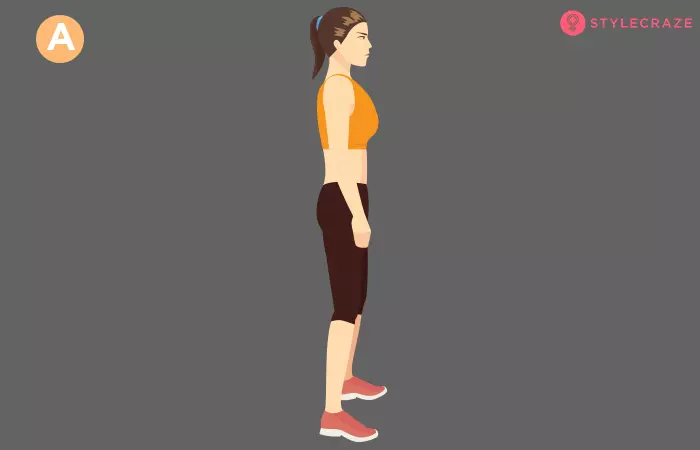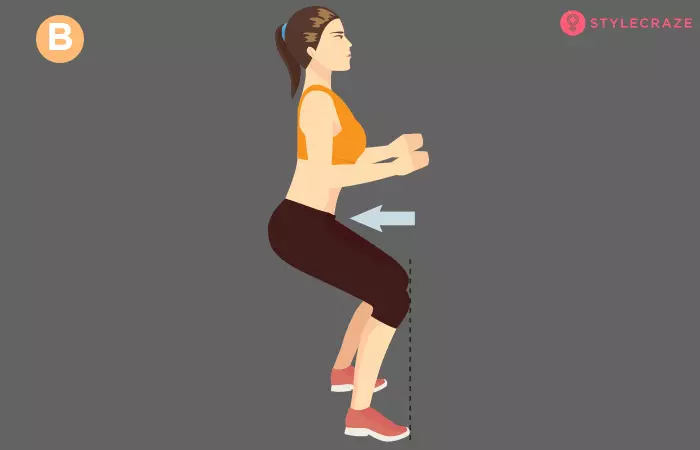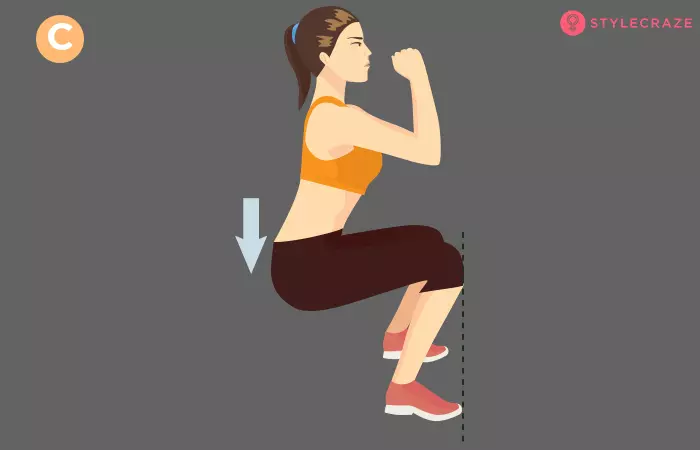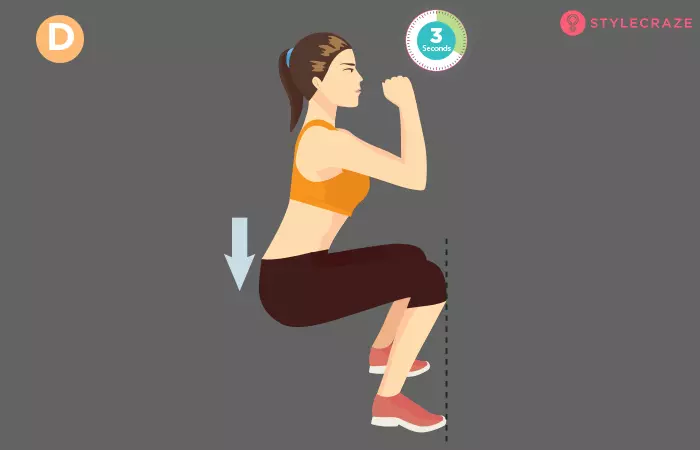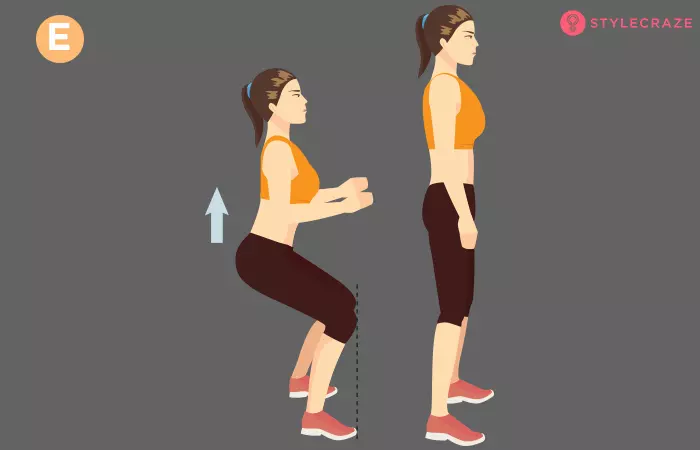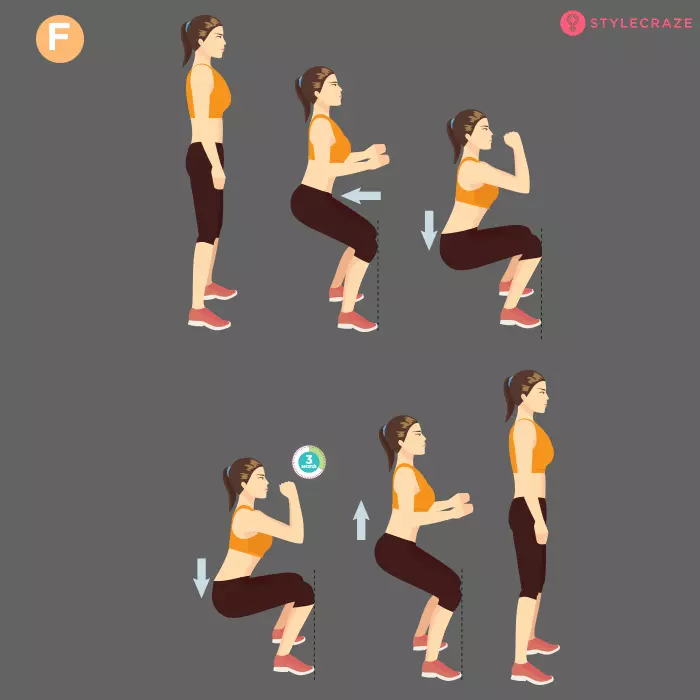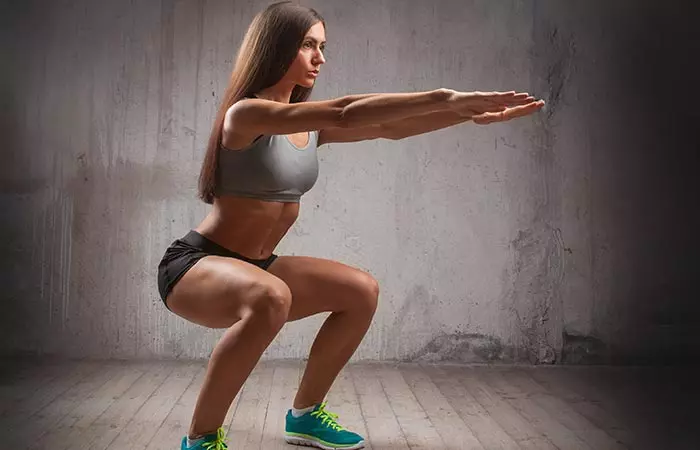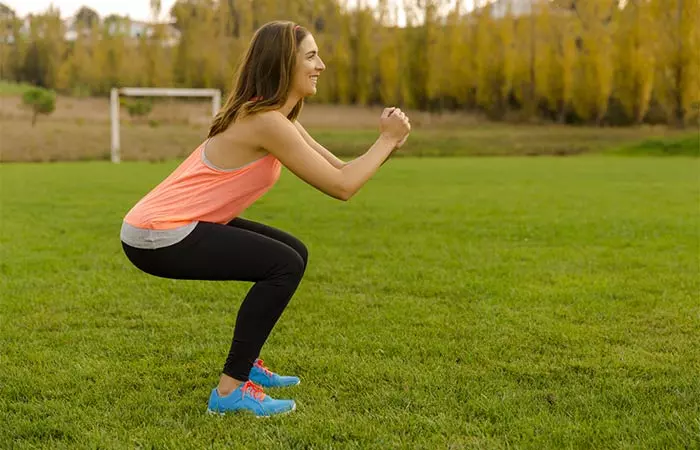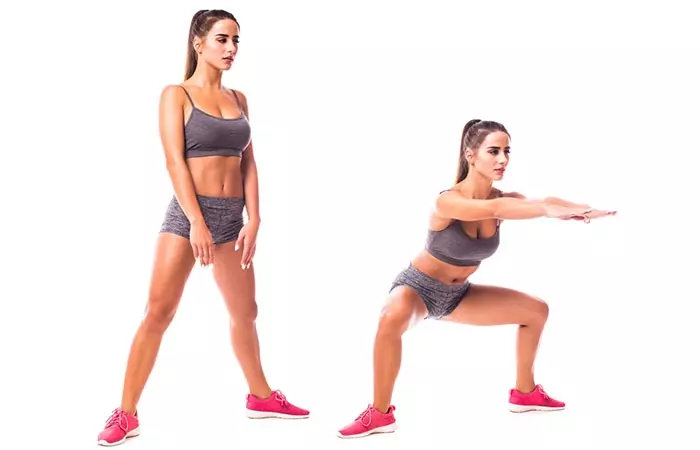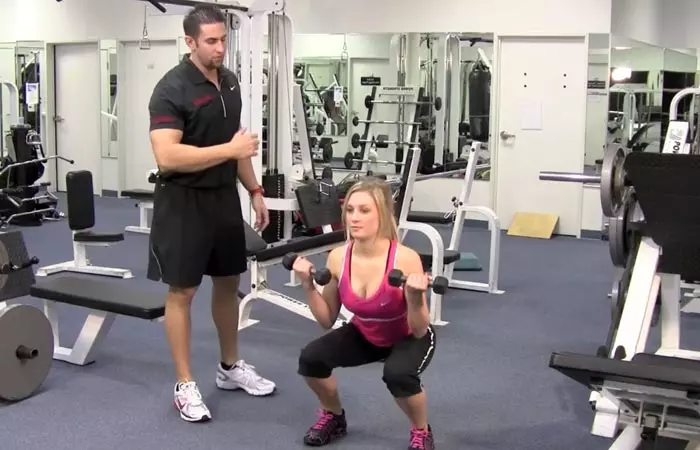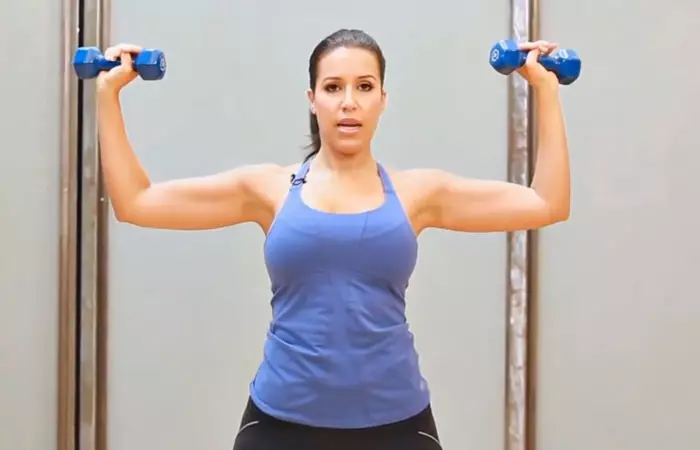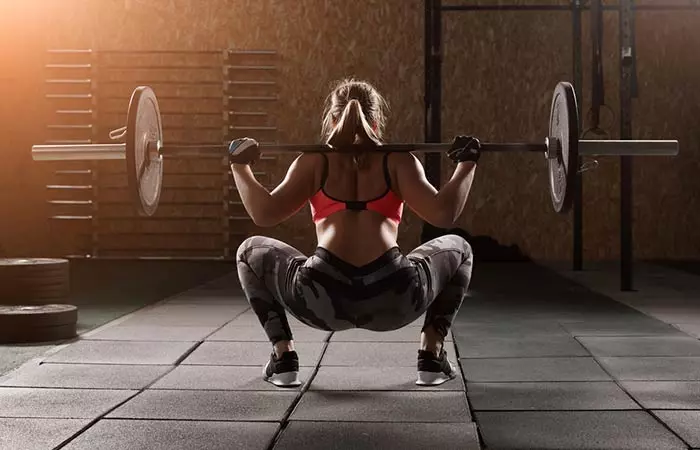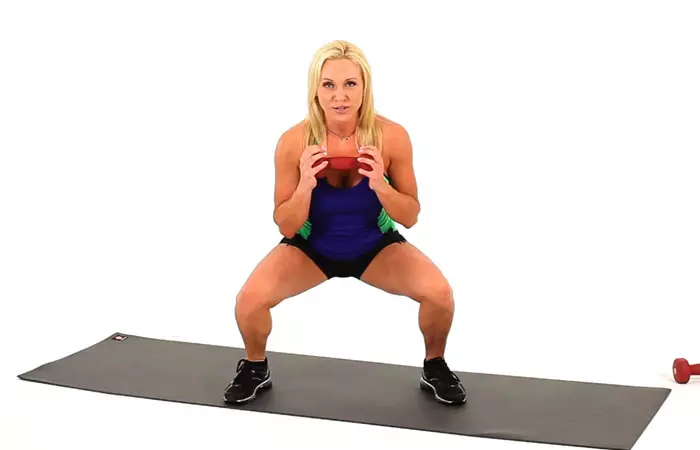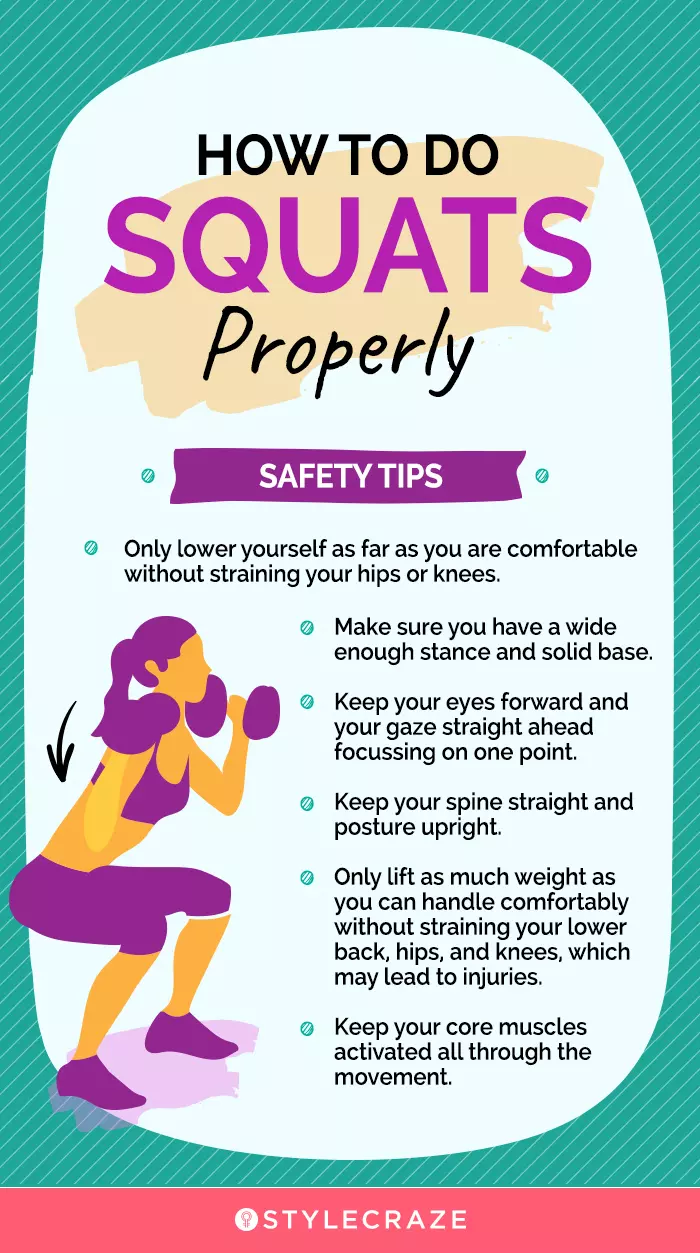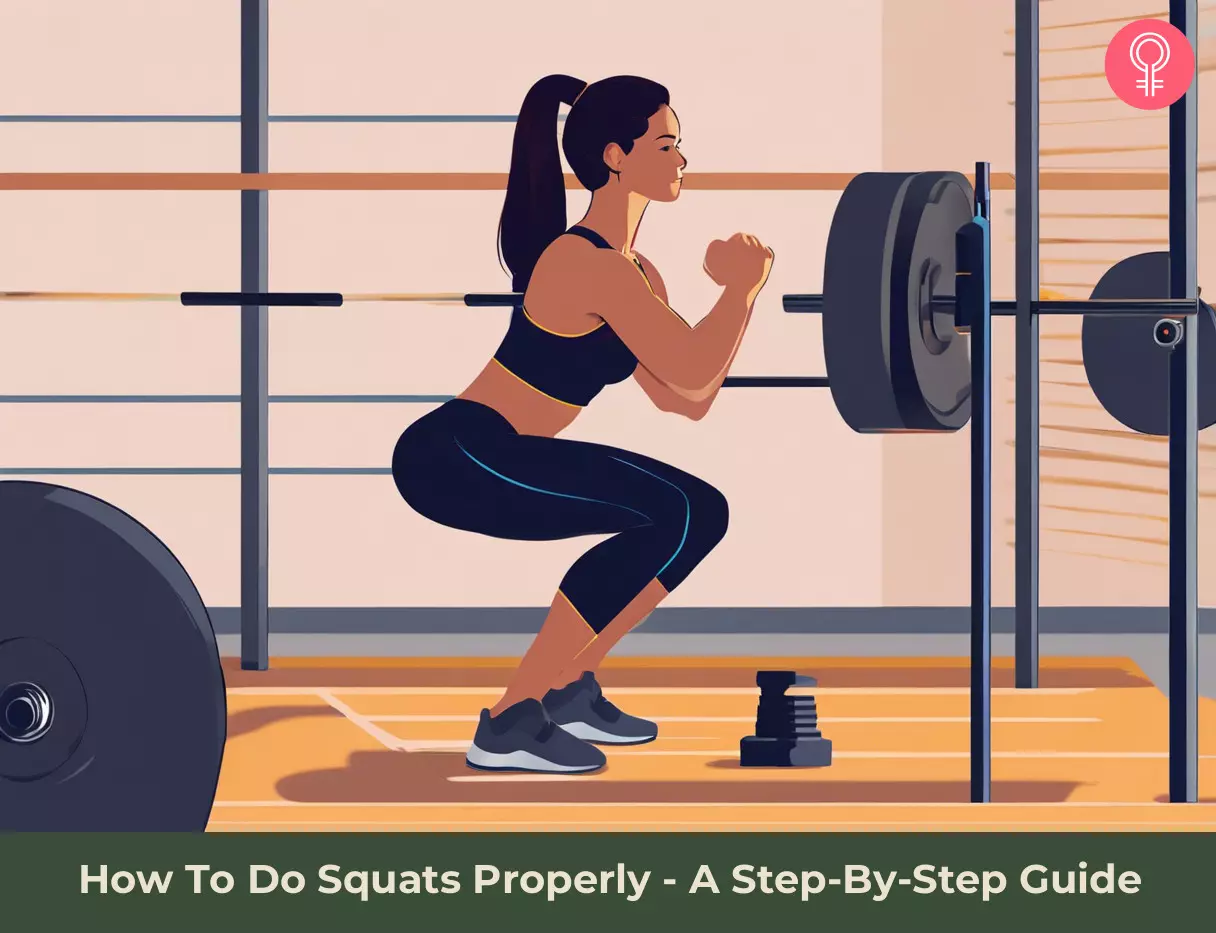The Beginner’s Guide To A Perfect Squat
Things You Need To Squat
Comfortable clothes Training shoes Headband and/or hair band
How To Squat Properly
Step 1: Starting PositionStand tall, with your back straight, feet a little more than hip-width apart and in a straight line, toes pointing slightly out (about 5-20 degrees), shoulders relaxed, and chest lifted . Look straight, with the arms extended in front of you, and squeeze your glutes so that your pelvic region is in symmetry with the imaginary straight line drawn from your left foot to the right. Step 2: Start Squatting
Look straight ahead, keep your back straight, and engage your core. Inhale, push your buttocks out, and start bending your knees. Your weight should be on your heels and NOT on your toes. Step 3: Full Squat
Push your buttocks out and look straight ahead. Sit down with your body weight on your heels. Your knees should not overshoot your toes. Go down until your hip joints are lower than your knees. Yes, this is the correct full squat. If your hip joints are not below the level of your knees, it’s a partial squat. Step 4: Hold
Keep your arms in front of you or grasp your right wrist with your left hand, and look straight. Make sure your pelvic region is in alignment with the toes, and your knees are not overshooting the toes. Your hips need to be pushed back, core tight, and glutes squeezed. Hold this pose for 3 seconds.
Exhale and start getting back up. Keep the body weight on your heels, shoulders pinched backward, and chest up. Push your hips forward and squeeze your glutes. Keep your legs straight. Step 6: Repeat
Again, inhale and go down to the squat position. Hold for 3 seconds, and come back up. Tip: Be slow when you are learning how to squat. There’s no hurry. Squatting correctly is more important than doing 3 sets of 30 squats.
9 Squats For Full Body To Burn Calories
1. Pulse Squat
Target Quads, hamstrings, hip flexorsi Muscles in the arm, hand, leg and foot that help bend a limb or another part of the body by contraction. , glutesi A group of three muscles that primarily make up the buttocks important for carrying out basic bodily movements like walking and standing. , calves, adductors, and core. Duration – 7 mins Steps
2. Explosive Squat
Target Quads, hamstrings, hip flexors, glutes, calves, adductors, core, lats, biceps, and neck muscles. Duration – 7 mins Steps
3. Squat Jump Forward And Back
Target Quads, hamstrings, hip flexors, glutes, calves, adductors, chest, and core. Duration – 10 mins Steps
4. Plie/Sumo Squats
Target Adductors, quads, hamstrings, hip flexors, calves, core, and back. Duration – 5 mins Steps
5. Squat With Bicep Curls
Target Quads, hamstrings, hip flexors, glutes, calves, adductors, chest, core, back, biceps, shoulders, and wrist extensors and flexors. Duration – 7 mins Steps
6. Squat With Overhead Press
Target Quads, hamstrings, hip flexors, glutes, calves, adductors, chest, core, back, biceps, shoulders, and lats. Duration – 10 mins Steps
7. Barbell Sumo Squat
Target Shoulders, glutes, lats, lower back, abs, quads, chest, triceps, biceps, hamstrings, calves, adductors, hip flexors, wrist flexors and extensors. Duration – 10 mins Steps
8. Goblet Squat
Target Glutes, core, quads, hamstrings, lower back, and shoulders. Duration – 7 mins Steps
9. Zercher Squat
Target Biceps, forearms, quadriceps, core, upper back, glutes, hamstrings Duration – 5 mins Steps
- Take a barbell and position it in the crook of your elbows and lock it in the front with your forearms. 2. Keep your feet shoulder-width apart. Keep your chest and back straight, and maintain this posture throughout. 3. Inhale and bend at the hips and knees to get into a squat, going as low as you are able to. Keep your torso upright and hold the position for a few seconds. 4. Ideally, your thighs should be parallel to the floor in the squat position. 5. Exhale and push from your heels and pull your hips back up to the starting position. 6. Do 3 sets of 10 reps each. These are different variations of squats that you can do to tone your body and shed fat. They include box squats, Smith machine squats, resistance band squats, Bulgarian split squats, barbell squats, dumbbell squats, front squats, wall squats, and plyometric squats. Steve Collins, a personal trainer and blogger, shared his experience of squatting in his personal blog. He said, “I know some people can’t do the front squat grip, in which case I would do a goblet squat with a dumbbell or kettlebell rack squats. I am not a big fan of the classic bodybuilding front squat with the arms crossed over, it looks like an accident waiting to happen (i).” As you practice more, you will get better, and squatting will become easier. Here’s a list of benefits that you get by squatting regularly.
Benefits Of Squats
Help burn the fat. Tone the muscles. Build muscle strength. Make real-life activities much easier. Improve stamina. Prevent injuries. Help flush out the toxins. Improve blood circulation. Help to get rid of cellulitei Non-malignant fat deposits that lie beneath the skin and create a dimpled and lumpy appearance. . Increase flexibility. Help build core strength/core engagement Improve posture. Strengthen the bones and joints. Glute activation Knee alignment
Can I do squats if I have knee pain? Before performing any workout, especially squats, you should speak with a doctor or physical therapist to identify the source of your knee pain and to gain clearance. To lessen the load on your knee and avoid additional injury, they can advise substituting exercises or making adjustments to the squats. How many squats should I do in a workout? Beginners must try to do 2-3 sets of 8–12 repetitions. Those on the Intermediate level must try to do 3–4 sets of 8–12 reps, and the ones on the advanced level must do 4-5 sets of 8–12 repetitions. What equipment do I need to do squats? You can perform squats by using your own body weight as resistance in place of any equipment. This is a fantastic method to begin creating stability and strength in your legs and glutes. You can also use handheld weights like dumbbells or kettlebells to perform squats. How can I progress to harder variations of squats? Try experimenting with novel squat variations, such as jump squats, pistol squats, sumo squats, and others. You can also include an unstable surface. Increase the difficulty level of squats by performing them on an unstable surface, such as a balancing disc or a Bosu ball. Each form is important in different ways; for example, the jump squats benefit your lower body and enhance cardiovascular fitness. How often should I do squats to see results? If you want to increase strength, you can do squats 2-3 times a week. If you want to work on endurance, you must do squats 2-4 times a week. If you are a beginner, try doing 2-3 sessions in a week and gradually keep increasing with time.
Illustration: How To Do Squats Properly - A Step-By-Step Guide
Learn how to do the perfect squat and achieve a stronger lower body. Get ready to tone your legs and glutes with this beginner-friendly workout video.
